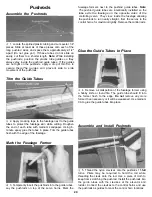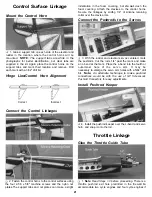
TAKEOFF: If you have dual rates on your transmitter, set
the switches to "high rate" for takeoff, especially when
taking off in a cross wind. Although the Ultra-Sport ARF
has good low speed characteristics, you should always
build up as much speed as your runway will permit before
lifting off, as this will give you a safety margin in case of a
"flame-out." When the plane has sufficient flying speed, lift
off by smoothly applying a little up elevator (don't force it
off into a vertical climb!), and climb out gradually.
FLYING: We recommend that you take it easy with your
Ultra-Sport ARF for the first several flights and gradually
"get acquainted" with this fantastic ship as your engine
gets fully broken-in. As you will quickly learn, the Ultra-Sport
ARF behaves like a "dream ship." It is incredibly smooth
and predictable, yet, still very maneuverable. Your
confidence will grow to the point that aerobatics are more
fun than ever. Just remember to take your time. Add and
practice only one maneuver at a time, learning how it
behaves during each one.
LANDING: When it's time to land, do a couple of slow
flybys at a safe altitude and get familiar with the plane's
slow flying characteristics.
Read and abide by the Academy of Model Aeronautics
Official Safety Code, a portion of which is reprinted here:
GENERAL
1. I will not fly my model aircraft in sanctioned events, air
shows, or model flying demonstrations until it has been
proven to be airworthy by having been previously,
successfully flight tested.
2. I will not fly my model higher than approximately 400
feet within 3 miles of an airport without notifying the airport
operator. I will give right-of-way and avoid flying in the
proximity of full-scale aircraft. Where necessary, an
observer shall be utilized to supervise flying to avoid
having models in the proximity of full-scale aircraft.
3. Where established, I will abide by the safety rules for
the flying site I use and will not willfully and deliberately fly
my models in a careless, reckless and/or dangerous manner.
7. I will not fly my model unless it is identified with my
name and address or AMA number, on or in the model.
Note: This does not apply to models flown indoors.
9. I will not operate models with pyrotechnics (any device
that explodes, burns, or propels a projectile of any kind)
including, but not limited to rockets, explosive bombs
dropped from models, smoke bombs, all explosive gases
(such as hydrogen-filled balloons), ground mounted
devices launching a projectile.
CAUTION (THIS APPLIES TO
ALL
R/C
A I R P L A N E S ) : If, while flying, you notice any
unusual sounds, such as a low-pitched "buzz", this
may be an indication of control surface "flutter."
Because flutter can quickly destroy components of
your airplane, any time you detect flutter you must
immediately cut the throttle and land the airplane!
Check all servo grommets for deterioration (this will
indicate which surface fluttered), and make sure all
pushrod linkages are slop-free. If it fluttered once, it
w i l l probably f l u t t e r again under similar
circumstances unless you can eliminate the slop or
flexing in the linkages. Here are some things which
can result in flutter: Excessive hinge gap; not
mounting control horns solidly; sloppy fit of clevis
pin in horn; elasticity present in flexible plastic
pushrods; side-play of pushrod in guide tube
caused by tight bends; sloppy fit of Z-bend in servo
arm; insufficient glue used when gluing the torque
rods into the control surfaces; excessive flexing of
aileron, caused by using too soft balsa aileron;
excessive "play" or "backlash" in servo gears; and
insecure servo mounting.
RADIO CONTROL
1. I will have completed a successful radio equipment
ground range check before the first flight of a new or
repaired model.
2. I will not fly my model aircraft in the presence of
spectators until I become a qualified flier, unless assisted
by an experienced helper.
3. I will perform my initial turn after takeoff away from the
pit or spectator areas and I will not thereafter fly over pit or
spectator areas, unless beyond my control.
4. I will operate my model using radio control frequencies
currently allowed by the Federal Communications
Commission. (Only properly licensed Amateurs are
authorized to operate equipment on Amateur Band
Frequencies.)
5. I will not knowingly operate an R/C system within 3
miles of a pre-existing model club flying site without a
frequency sharing agreement with that club.
27





































